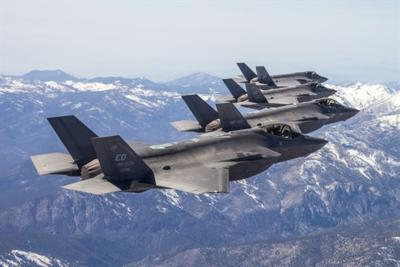Wed, Dec 14, 2016
All Three Variants Participate In Multi-Ship Testing
All three variants of the F-35 Joint Strike Fighter were used by the 461st Flight Test Squadron in recent multi-ship testing, which employs four or six jets to ensure communication systems between the planes are working properly and accurately.

The F-35 contains state-of-the-art tactical data links that provide the secure sharing of data among its flight members as well as other airborne, surface and ground-based platforms required to perform assigned missions.
“One of the primary reasons we do multi-ship testing is to ensure data is shared appropriately between aircraft in order to maximize lethality and survivability,” said Maj. Raven LeClair, 461 FLTS, F-35 test pilot. “The F-35 uses [Multifunction Advanced Data Link] to share information on air and ground threats in order to more effectively target. This is especially applicable to one of the F-35’s primary missions - finding and killing advanced surface-to-air missile systems.”
The MADL is a high-data-rate, directional communications link that allows secure transmission of coordinated tactics and engagement for the fifth-generation fighter when operating in high-threat environments.
LeClair said his squadron is specifically testing the ability to find SAM systems using a capability called Enhanced Geo Location.
He added the MADL architecture is divided into flight groups so it is important to test the capability to pass data between flight groups using four or six aircraft to ensure system accuracy, stability and usability during large force exercises and actual combat.
According to the Air Force, the F-35 has unprecedented situational awareness. The F-35’s advanced sensor package is designed to gather, fuse and distribute more information than any fighter in history, which gives pilots a decisive advantage over all adversaries.
“Having a common battlefield picture is one of the greatest assets in combat,” LeClair said. “This capability must be proven to be secure and ensure maximum interoperability between 4th and 5th-generation fighters. The F-35 has an incredible capability to show the entire tactical picture and being able to share this tactical picture with all forces is critical to maximizing lethality, survivability and minimizing the risk of fratricide.”
The F-35 is designed to replace aging fighter inventories including U.S. Air Force F-16s and A-10s, U.S. Navy F/A-18s, U.S. Marine Corps AV-8B Harriers and F/A-18s, and U.K. Harrier GR.7s and Sea Harriers.
The 461st FLTS and Joint Strike Fighter Combined Test Force at Edwards AFB conducts developmental test and evaluation of the F-35 with all three variants – the A, B and C models. Developmental test and evaluation will make way for future operational tests.
“As we approach the end of System Development and Demonstration phase, many of our capstone testing events will be multi-ship to ensure compliance with the requirements before transitioning to operational testing,” said LeClair.
(Image provided with USAF news release)
More News
Aero Linx: Model Aeronautical Association of Australia MAAA clubs are about fun flying, camaraderie and community. For over 75 years, the MAAA has been Australia’s largest fl>[...]
Touchdown Zone Lighting Two rows of transverse light bars located symmetrically about the runway centerline normally at 100 foot intervals. The basic system extends 3,000 feet alon>[...]
“Discovery and innovation are central to our mission at Virgin Galactic. We’re excited to build on our successful record of facilitating scientific experiments in subor>[...]
How To Get A Story On Aero-TV News/Feature Programming How do I submit a story idea or lead to Aero-TV? If you would like to submit a story idea or lead, please contact Jim Campbel>[...]
Student Pilot Reported That During Rotation, “All Of A Sudden The Back Of The Plane Kicked To The Right..." Analysis: The student pilot reported that during rotation, “>[...]
 ANN's Daily Aero-Linx (05.02.24)
ANN's Daily Aero-Linx (05.02.24) ANN's Daily Aero-Term (05.02.24): Touchdown Zone Lighting
ANN's Daily Aero-Term (05.02.24): Touchdown Zone Lighting Aero-News: Quote of the Day (05.02.24)
Aero-News: Quote of the Day (05.02.24) ANN FAQ: Contributing To Aero-TV
ANN FAQ: Contributing To Aero-TV NTSB Final Report: Cirrus Design Corp SR20
NTSB Final Report: Cirrus Design Corp SR20



